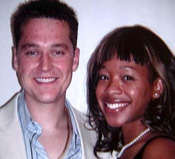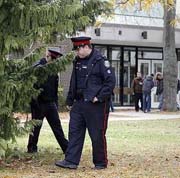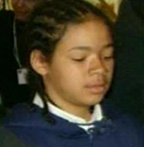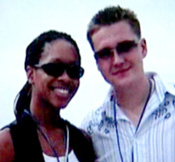Saturday, 15 November 2008
 The day after the inspirational election of Barack Obama, four US Marines ("including one known as ‘Psycho,’") were charged "with the execution-style slayings" of a young mixed-race couple "in Winchester, in Riverside County southeast of Los Angeles" (aka "an exurb of San Diego"). Like others, no doubt, I was having trouble understanding the grisly murders of Jan Pietrzak and Quiana Jenkins-Pietrzak here — until I caught up with Paul Haggis’s 2007 movie In the Valley of Elah on TV. Or so I thought. One of the movie’s gripping messages seems to be that the long Iraq War, in a dusty burnt-out centre of ancient civilization, has hideously brutalized the US military. Yet even up in Canada, in what used to be called Toronto the Good, we have now had the release of a long-awaited government report on youth violence. It was commissioned after the death of Jordan Manners, who was shot last year at "C.W. Jefferys Collegiate Institute, where a serious stabbing also occurred this week." This was only "the latest in a series of recent school-related violent incidents in Toronto." It is apparently not just the US military that has been brutalized in the early 21st century. And it isn’t just the Iraq War that lies at the bottom of disturbing new waves of domestic violence in both the United States and Canada. The day after the inspirational election of Barack Obama, four US Marines ("including one known as ‘Psycho,’") were charged "with the execution-style slayings" of a young mixed-race couple "in Winchester, in Riverside County southeast of Los Angeles" (aka "an exurb of San Diego"). Like others, no doubt, I was having trouble understanding the grisly murders of Jan Pietrzak and Quiana Jenkins-Pietrzak here — until I caught up with Paul Haggis’s 2007 movie In the Valley of Elah on TV. Or so I thought. One of the movie’s gripping messages seems to be that the long Iraq War, in a dusty burnt-out centre of ancient civilization, has hideously brutalized the US military. Yet even up in Canada, in what used to be called Toronto the Good, we have now had the release of a long-awaited government report on youth violence. It was commissioned after the death of Jordan Manners, who was shot last year at "C.W. Jefferys Collegiate Institute, where a serious stabbing also occurred this week." This was only "the latest in a series of recent school-related violent incidents in Toronto." It is apparently not just the US military that has been brutalized in the early 21st century. And it isn’t just the Iraq War that lies at the bottom of disturbing new waves of domestic violence in both the United States and Canada.
The Pietrzak murders in Southern California ...
 One question the Pietrzak murders raise (and the movie In the Valley of Elah finally seems to answer) is how can US Marines kill each other, stateside as it were? Along with the four who have been charged with his murder, Sgt. Jan Pietrzak, 24, was a Marine himself. More exactly, he "was a helicopter airframe mechanic at Miramar Marine Corps Air Station in San Diego" (also associated with Camp Pendleton — "the major West Coast base of the United States Marine Corps"). One question the Pietrzak murders raise (and the movie In the Valley of Elah finally seems to answer) is how can US Marines kill each other, stateside as it were? Along with the four who have been charged with his murder, Sgt. Jan Pietrzak, 24, was a Marine himself. More exactly, he "was a helicopter airframe mechanic at Miramar Marine Corps Air Station in San Diego" (also associated with Camp Pendleton — "the major West Coast base of the United States Marine Corps").
Two of the four Marines charged with the murder of Sgt. Pietrzak and his wife — Lance Cpl. Emrys John, 18, of Maryland, and Lance Cpl. Tyrone Miller, 20, of North Carolina — actually worked for Pietrzak at the Miramar Air Station. (The other two Marines charged in the case are Pvt. Kevin Cox, 20, of Tennessee, and Lance Cpl. Kesaun Sykes, 21, of California. Sykes is the one known as "Psycho.")
Pietrzak was born in Poland and raised in Brooklyn, N.Y. He joined the Marines in 2003 and served in Iraq from July 2005 to February 2006. He met Quiana Jenkins, who worked for a local Black Infant Care Center, three years ago at a party for Marines being deployed to Iraq. They were finally married just this past August 8, 2008. (According to Pietrzak’s mother: "They were in love ... It didn't matter to them that they had different skin colors.")
 In another bow to current "depression economics," the Pietrzaks had purchased their five-bedroom home in the Winchester exurb of San Diego through a foreclosure. Jan Pietrzak "used his reenlistment bonus to replace the hardwood floor and carpet." Both Jan and Quiana have been described by a family friend as "hardworking young people." In another bow to current "depression economics," the Pietrzaks had purchased their five-bedroom home in the Winchester exurb of San Diego through a foreclosure. Jan Pietrzak "used his reenlistment bonus to replace the hardwood floor and carpet." Both Jan and Quiana have been described by a family friend as "hardworking young people."
Jan and Quiana had been married for a mere two months and one week, when they were "found gagged, tied and shot in the head ... in the living room of their home," on October 15, 2008. (Sheriff's deputies had been called after Sgt.Pietrzak failed to show up for work at Miramar Marine Corps Air Station.) The "home was ransacked and jewelry and other items were taken, investigators said. A fire was set, apparently in an effort to destroy evidence."
The current official story appears to be that the four Marines who have now been charged were motivated in the first instance by a plot to steal from the Pietrzaks. They "acknowledged they had roles in the robbery, sexual assault [of Quiana] and murder ... [Lance Cpl. Tyrone] Miller told a sheriff's investigator that he forced his way into the home by pointing a shotgun at Pietrzak ... Miller said he and the others went to Pietrzak's home to rob him ... [Miller] tied up the couple and discussed with [Lance Cpl. Emrys] John whether to kill them ...
 "The other two Marines acknowledged they went to the home to rob Pietrzak. All four said his wife was sexually assaulted, although each said it was the other three who committed the attack." Apparently "shoes found at the barracks where [Pvt. Kevin] Cox and John lived matched prints left at the crime scene, and property believed stolen from the house was found at [Lance Cpl. Kesaun] Sykes's home." All four men have each been "charged with two counts of first-degree murder and special-circumstance allegations of committing multiple murders, committing the crime during a robbery, and rape by instrument." "The other two Marines acknowledged they went to the home to rob Pietrzak. All four said his wife was sexually assaulted, although each said it was the other three who committed the attack." Apparently "shoes found at the barracks where [Pvt. Kevin] Cox and John lived matched prints left at the crime scene, and property believed stolen from the house was found at [Lance Cpl. Kesaun] Sykes's home." All four men have each been "charged with two counts of first-degree murder and special-circumstance allegations of committing multiple murders, committing the crime during a robbery, and rape by instrument."
As various commentators have noted (including the mothers of both victims), conventional robbery seems like a very slender motivation for such appalling crimes, committed by four Marines against another Marine and his wife. In the current era of what Paul Krugman calls depression economics, envy of the Pietrzaks’ five-bedroom house, acquired through a foreclosure by the boss of two of the assailants, could be part of a more exact explanation.
Photos of the four Marines who have been charged, published on the net, could be said to show as well that they are all black. And the rape of Quiana could be read as suggesting some tribalist resentment of the Pietrzaks’ mixed-race marriage. Yet the photos that have been published equally suggest that all four assailants are fundamentally mixed-race themselves. (Even if the crudest stereotypes of North American popular culture still do tend to label any mixed-race person with any degree of visible "black" ancestry as black rather than white — and, in the United States at least, there is no polite shorthand or label for "mixed-race" at all.)
 The still deeper explanation suggested by Paul Haggis’s 2007 movie In the Valley of Elah would appear to be that US military culture has been dramatically "dysfunctionalized" by the often problematic and agonizing struggles of the past several years in Iraq and Afghanistan. Too many among the new warriors of the new US neo-imperialism and the hyper-aggressive doctrine of pre-emptive war have become radically disoriented psychologically, so to speak. And too often they have begun to take this disorientation out on each other, in an almost random way. The still deeper explanation suggested by Paul Haggis’s 2007 movie In the Valley of Elah would appear to be that US military culture has been dramatically "dysfunctionalized" by the often problematic and agonizing struggles of the past several years in Iraq and Afghanistan. Too many among the new warriors of the new US neo-imperialism and the hyper-aggressive doctrine of pre-emptive war have become radically disoriented psychologically, so to speak. And too often they have begun to take this disorientation out on each other, in an almost random way.
No doubt this reading of events carries the troubles of the present to some ultimately not altogether realistic extreme. But even the workmanlike Wikipedia plot summary for In the Valley of Elah draws attention to a striking metaphor. Early on in the movie: "Though hurrying to the army base, Hank takes the time to stop at the local school, where the United States flag has mistakenly been hung upside down. Explaining to the school custodian, who is from El Salvador, that the American standard hanging upside down is a signal of distress, according to the United States Flag Code, he helps the caretaker righten it before continuing on his way."
And then, at the very end of things: "With the crime finally solved and the men from Mike's squadron revealed as his killers, Hank returns home to find a flag his son had mailed from overseas, along with a picture of it flying over his squad in Iraq. His faith shattered, Hank takes the flag to the school and hoists it upside down. He duct tapes the ropes of the flag staff and instructs the school's custodian to leave it that way permanently."
Knives and handguns in Toronto the not-so-good-any-more ...
 Even long before 9/11 and all that, there has also been a parallel broader revival of old social Darwinist doctrines of the survival of the fittest humans — and such related policy concepts as Joseph Schumpeter’s "creative destruction" in economic development — over the past quarter century or so. And (as useful as at least the notion of creative destruction in the economy can sometimes be) this has, quite arguably, generated its own broader brutalizing tendencies, especially in already disoriented and unstable less-affluent sectors of North American society. Even long before 9/11 and all that, there has also been a parallel broader revival of old social Darwinist doctrines of the survival of the fittest humans — and such related policy concepts as Joseph Schumpeter’s "creative destruction" in economic development — over the past quarter century or so. And (as useful as at least the notion of creative destruction in the economy can sometimes be) this has, quite arguably, generated its own broader brutalizing tendencies, especially in already disoriented and unstable less-affluent sectors of North American society.
"The only trouble with rugged individualism," the old leader of the New Democratic Party in Canada, Tommy Douglas, used to say in an earlier era, "is that it creates so many ragged individuals." Especially in an age of increasingly absurd and dysfunctional drug laws, perhaps, many younger ragged individuals in disoriented cultural pockets have much better access to much more technologically sophisticated and dangerous knives and handguns.
There can of course be little doubt that "Toronto the Good" — which descends from the title of an 1898 book by one C.S. Clark (which also bore the motto "Not necessarily Toronto alone but every city in America") — has always had something of an air of smug provincial hyperbole about it.
 Like every big city everywhere, no doubt, Toronto has always had an assortment of problems with crime. In the late 19th century the city’s expatriate British historian Goldwin Smith used to complain about the "boy problem" on Toronto streets — by which he seems to have meant something like what we now dignify as youth crime, and so forth. Like every big city everywhere, no doubt, Toronto has always had an assortment of problems with crime. In the late 19th century the city’s expatriate British historian Goldwin Smith used to complain about the "boy problem" on Toronto streets — by which he seems to have meant something like what we now dignify as youth crime, and so forth.
Yet to just casual older observers who have lived in this city most of their lives, in the early 21st century it certainly does seem that too many city schools are not as safe as they used to be. The very notion that a student could actually be shot dead — or grievously stabbed — in any city school is certainly something I find quite outrageous myself. And in the past few years there have similarly been a few too many reports of accidental deaths from wayward gunfire, in too many ordinary public places I typically frequent from time to time myself.
A quarter of a century ago many people felt they could say with very little hesitation that, certainly as such things go in North America, Toronto was an unusually safe city. Like most other Canadian cities, it probably still is a comparatively safe place. But I certainly don’t feel I can say it is as safe a city as it used to be. And, like many others again, no doubt, I am nowadays much more hesitant about extolling Toronto, Canada as a safe city.
 There is also at least some wisdom, I think, in the proposition that the Pietrzak murders in Southern California and knives and handguns in Toronto the not-so-good-any-more are not entirely un-related. In Canada we used to think that we were largely isolated from at least the most distressing urban pathologies in the big cities of the United States. But this nowadays seems an increasingly vain thought at best. There is also at least some wisdom, I think, in the proposition that the Pietrzak murders in Southern California and knives and handguns in Toronto the not-so-good-any-more are not entirely un-related. In Canada we used to think that we were largely isolated from at least the most distressing urban pathologies in the big cities of the United States. But this nowadays seems an increasingly vain thought at best.
Similarly, the recent inspirational election of Barack Obama of course has nothing directly to do with Canada at all. But as more than one opinion poll has shown he is very popular in Canada. And when he talked about "change" and "yes we can," today’s new problems of big-city (and rising small- rural-area) crime were one of the things Canadians like me at least were thinking need to be changed — regardless of what some say about what is possible in what will no doubt remain largely ruggedly individualist societies.
Perhaps here as in other contexts, the larger world is just bound to be disappointed by Obamamania in practice. Just too much is being expected, and on and on and on, etc, etc. It is part of the audacity of hope, however, to keep on hoping. Something certainly does need to be done about crime in the streets (and especially in the schools) nowadays. And the neo-con formulae of the likes of Stephen Harper in Canada do seem far too much tied into the broader pathological trends that are at the bottom of so many of our current problems in the first place.
 "Marines are supposed to be brothers," Jan Pietrzak's mother has complained to her local press: "What kind of brothers are these?" She is right, of course. And, if you ask me, she is also pointing pretty clearly to one of the biggest changes that need to be made. (Or, are we our brothers’ keepers? Yes we can, indeed.) "Marines are supposed to be brothers," Jan Pietrzak's mother has complained to her local press: "What kind of brothers are these?" She is right, of course. And, if you ask me, she is also pointing pretty clearly to one of the biggest changes that need to be made. (Or, are we our brothers’ keepers? Yes we can, indeed.)
PS: (1) The four marines charged in the Pietrzak murders are currently "being held in jail and [are] due in court on Thursday, November 20 [2008]. Prosecutors said they had not decided whether to seek the death penalty" (which is apparently possible in this case in California: it would not be in Canada of course, for better or worse).
(2) The long-awaited Ontario government report "by retired Ontario chief justice Roy McMurtry and former Liberal MPP Alvin Curling ... ordered in the wake of the May 2007 shooting death of student Jordan Manners at C.W. Jefferys Collegiate Institute" was finally released on November 14, 2008. For a brief account see the Toronto Star article, "McGuinty eyes race stats," Saturday, November 15. Only registered users can write comments.
Please login or register. Powered by AkoComment 1.0 beta 2!
|
